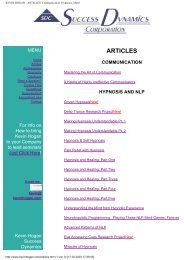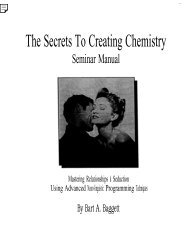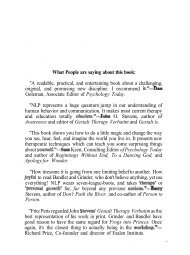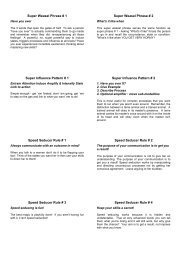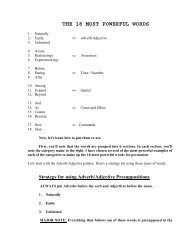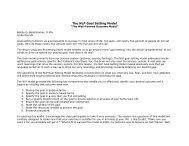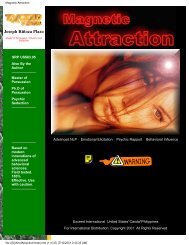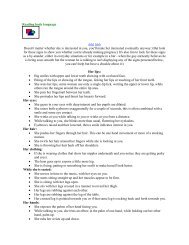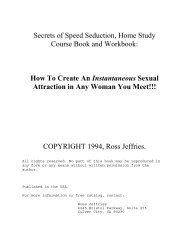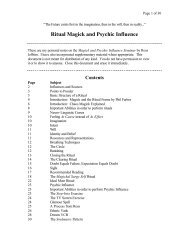A Pragmatic Guide To Communication & Change.pdf - NLP Info Centre
A Pragmatic Guide To Communication & Change.pdf - NLP Info Centre
A Pragmatic Guide To Communication & Change.pdf - NLP Info Centre
- No tags were found...
You also want an ePaper? Increase the reach of your titles
YUMPU automatically turns print PDFs into web optimized ePapers that Google loves.
sequence of responses. The form was rigid and predictable, and everyone knew what<br />
was expected.<br />
A more current example of social constraints concerns socially imposed "rules"<br />
governing direct eye contact. 1 z There are subcultures in the United States that believe that<br />
if one man stares directly into the eyes of another man, it is a "challenge," much like the<br />
traditional "glove-in-the-face slap" that initiated the duel ritual. In these situations, again<br />
highly regulated by custom, there are specific things that each man is expected to do. The<br />
challenge is either accepted or declined, depending on the response of the second man to<br />
the initiating stare.<br />
Problems may result if two or more individuals are combined from different subcultures<br />
with different rules or customs. In an institutional setting, for example, where many<br />
differing subcultures are forced to co-mingle, inability to predict expected responses<br />
creates the potential for very volatile interactions. For those responsible for maintaining<br />
order, the process of "keeping the peace" becomes a labrious and sometimes harrowing<br />
experience.<br />
Any time we are confronted with a situation where two models differ, as in the above<br />
example, it becomes crucial to determine what the rules are for each of the models. These<br />
social constraints on the models, properly utilized, are invaluable in the process of<br />
gaining rapport, in "speaking the some language" of the parties involved. Using these<br />
rules can help create the trust and free-flowing communication necessary for successful<br />
positive interventions. Understanding the impact of social constraints on the eommunication<br />
process is one of the ways of orienting yourself to the inevitable differences in each<br />
individual's model of the world. Identifying and then honoring these constraints will<br />
prevent them from blocking the communication process.<br />
Individual Constraints<br />
As pointed out by L.K. Ferguson in Personality Deuelopntent, "'Personality' is a term<br />
that has been defined more variously than perhaps any other general concept in<br />
psychology." (p, 2) 'faking into account an individual's genetic makeup, Ferguson makes<br />
a valid argument for an<br />
2,3<br />
20<br />
21<br />
for sounds, and OG for smell and taste. For every moms<br />
there is one complete set of these experiences, b;, ie<br />
h nt As J. Samuel<br />
Bois, the general semanticist, observs in The<br />
these sets is called a 4-tuple. of A r<br />
t of Awareness, ' . I don't see the same<br />
things, don't observe the same events, when I change from my French to my English<br />
brain." He goes on to say, "Changing my<br />
ge changes me as<br />
langua an observer. It changes my world at<br />
the same trims." (P. 20)<br />
Figure I - 2 shows the language component being added to the 4 triple. This either<br />
accentuates certain aspects of the neurological model or deletes or distorts it. It can<br />
enhance perception as in the case of the Eskimos. Even though I could



